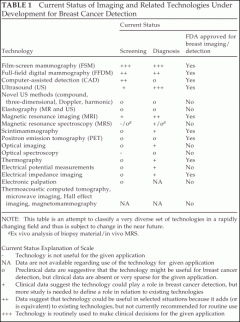Technologies in Development
Most of the progress thus far in the field of breast cancer detection has resulted in incremental improvements in traditional imaging technologies. These technical advances have likely led to more consistent detection of early lesions, but clinical trials have not been undertaken to determine whether their use has also resulted in a greater reduction in breast cancer mortality compared with that of older technologies. Many technical improvements have been made to mammography since its initial introduction. One recent example is full-field digital mammography (FFDM). FFDM systems are identical to traditional film-screen mammography (FSM) systems except for the electronic detectors that capture and display the X-ray signals on a computer rather than directly on film. This digital process provides the opportunity to adjust the contrast, brightness, and magnification of the image without additional exposures.
Many consider FFDM to be a major technical advance over traditional mammography, but studies to date have not demonstrated a meaningful improvement in screening accuracy. Although one could argue that studies thus far have not directly tested the full potential of FFDM through the use of “soft-copy” image analysis (on a computer screen as opposed to film), difficulties remain with regard to the limited resolution and brightness of the soft-copy display. The technology could potentially improve the practice of screening mammography in other ways, for example, by facilitating electronic storage, retrieval, and transmission of mammograms.
Computer-aided detection, through the use of sophisticated computer programs designed to recognize patterns in images, has also shown potential for improving the accuracy of screening mammography, at least among less experienced readers. However, questions remain as to how this technology will ultimately be used and whether it will have a beneficial effect on current screening practices.
Other breast imaging technologies approved by the Food and Drug Administration (FDA) include ultrasound, magnetic resonance imaging (MRI), scintimammography, thermography, and electrical impedance imaging (Table 1).
 TABLE 1 - Current Status of Imaging and Related Technologies Under Development for Breast Cancer Detection
TABLE 1 - Current Status of Imaging and Related Technologies Under Development for Breast Cancer Detection
NOTE: This table is an attempt to classify a very diverse set of technologies in a rapidly changing field and thus is subject to change in the near future.
Ideal detection performance may ultimately depend on multimodality imaging, as no single imaging technology to date can accurately detect all significant lesions. Ultrasound and MRI in particular have shown potential as adjuncts to mammography for diagnostic and screening purposes, especially for women in whom the accuracy of mammography is not optimal, such as those with dense breasts. MRI and ultrasound imaging may also facilitate new minimally invasive methods for the treatment of early lesions that are under investigation, but clinical trials are needed to assess the value of the procedures.
Many additional technologies are at earlier stages of development, but to date, it appears that no quantum steps forward have been taken in this area. Furthermore, improved imaging technologies that allow detection of more lesions at an earlier, precancer stage may or may not lead to reduced breast cancer mortality and may lead to more overtreatment of women.
The dilemma of overtreatment could potentially be overcome by coupling imaging technologies with biologically based technologies, such as functional imaging, that can determine which lesions are likely to become lethal. The benefit of discovering early lesions could also be enhanced by developing new and effective preventive and therapeutic interventions that are minimally invasive and more acceptable to women.